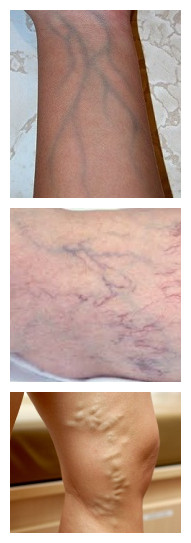Veins showing through skin area is not uncommon in people, especially those with pale skin. Some may get concerned about this issue. While unpleasant to the eyes, veins that can be seen through skin are usually harmless and don't affect blood circulation or health. Even though the condition usually doesn't require any treatment, a visit to your doctor may very well relieve all your worries about its causes, treatments, etc.
Why Are My Veins Showing Through Skin?
Why can I see my veins? Well, the answer to your question may vary depending on the fact if it's a recent development or has been there forever. But one of the following may be a cause in your case.
1. Most Common Causes
- People with a fair complexion have more visible veins as compared to others.
- Similarly, thin people have less fat to hide veins, leading to visible veins.
- Veins too close to the skin may also be more visible. This is especially true for veins in legs, which are involved in transporting small amount of blood to heart.
2. Weight Lifting
While an exercise as strenuous as weight lifting builds body, it also exerts pressure on your blood vessels making them rigid, and causing them to bulge and become more visible. Weight lifting doesn't directly affect veins; instead, it affects the surrounding muscles and an increase in muscle size and density makes the veins visible even during relaxing.
3. Aging
Age is another important cause of visible veins. Here the veins showing through skin become more and more visible with age because of the thinning of fat layer. The fat layer is thickest in children and gets thin with aging. The effects of aging are more obvious in smokers, which is why they have prominent veins as compared to the rest.
4. Certain Medication Reaction
Skin thinning eventually leading to visible veins could be a medicine reaction as well. If visible veins have become a concern, you should stop using steroids. At times body produces abnormal amounts of steroids (like in Cushing syndrome) making your veins too visible.
5. Pregnancy
Pregnancy is not only marked by a growing belly, but a growing network of blood vessels too. Why? Well, for starters your blood volume increases by 20%-40% and with the passage of time, your baby's demands of food and nutrients also increases. In order to achieve this balance between demand and supply, the network of veins expands. Good news is that this isn't forever and will effortlessly resolve once the baby is delivered. While breastfeeding moms would continue to have visible veins on breasts, their problem will also be solved once weaning begins.
6. Spider Veins vs. Varicose Veins
Getting their name from the web-like pattern, spider veins are frequently seen on face and legs. These superficial veins can be red, blue or purple in color. Varicose veins on the other hand are dark blue, swollen, distorted, large veins showing through skin that sometime stick out as well. Varicose veins can develop anywhere but are frequently found on ankles and legs. Varicose veins are likely to develop in people on their feet throughout the day, like teachers and nurses.
Visible veins like small spider veins can be concealed with self-tan lotion or water-resistant cosmetic. Management of these conditions may also include wearing properly-fitting supportive stocking, maintaining hygiene, losing weight, trying sclerotherapy, endovenous laser treatment and radiofrequency occlusion. Surgical interventions can be used, like tying off vein or removing a long segment of vein to relieve the condition.
7. Other Causes
Other causes that can lead to visible veins include heart disease (eventually causing heart attack), smoking, genetics and excessive stress.
When to Worry About Veins Showing Through Skin
Visible veins undoubtedly don't pose a serious threat to health, but you should be cautious about certain signs and their appearance should prompt you to visit the doctor. Immediate medical attention should be sought, if one or more of the following are experienced:
- If veins start to bleed
- If veins become red-colored, swollen, sore and warm to the touch
- There are changes in color of skin or in its texture
- Sore skin or rashes on skin
- Significant distress caused by such changes
- Painful varicose veins along with other particular symptoms
